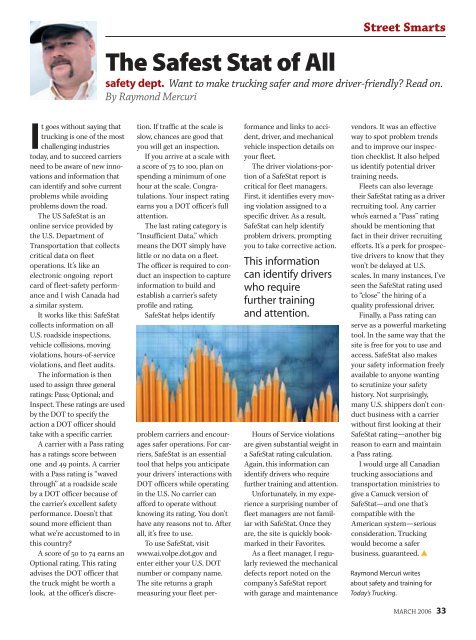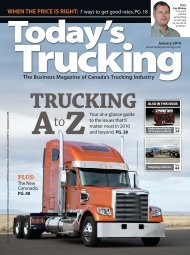Create successful ePaper yourself
Turn your PDF publications into a flip-book with our unique Google optimized e-Paper software.
It goes without saying that<br />
trucking is one of the most<br />
challenging industries<br />
today, and to succeed carriers<br />
need to be aware of new innovations<br />
and information that<br />
can identify and solve current<br />
problems while avoiding<br />
problems down the road.<br />
The US SafeStat is an<br />
online service provided by<br />
the U.S. Department of<br />
Transportation that collects<br />
critical data on fleet<br />
operations. It’s like an<br />
electronic ongoing report<br />
card of fleet-safety performance<br />
and I wish Canada had<br />
a similar system.<br />
It works like this: SafeStat<br />
collects information on all<br />
U.S. roadside inspections,<br />
vehicle collisions, moving<br />
violations, hours-of-service<br />
violations, and fleet audits.<br />
The information is then<br />
used to assign three general<br />
ratings: Pass; Optional; and<br />
<strong>In</strong>spect. These ratings are used<br />
by the DOT to specify the<br />
action a DOT officer should<br />
take with a specific carrier.<br />
A carrier with a Pass rating<br />
has a ratings score between<br />
one and 49 points. A carrier<br />
with a Pass rating is “waved<br />
through” at a roadside scale<br />
by a DOT officer because of<br />
the carrier’s excellent safety<br />
performance. Doesn’t that<br />
sound more efficient than<br />
what we’re accustomed to in<br />
this country?<br />
Ascore of 50 to 74 earns an<br />
Optional rating. This rating<br />
advises the DOT officer that<br />
the truck might be worth a<br />
look, at the officer’s discre-<br />
Street Smarts<br />
The Safest Stat of All<br />
safety dept. Want to make trucking safer and more driver-friendly? Read on.<br />
By Raymond Mercuri<br />
tion. If traffic at the scale is<br />
slow, chances are good that<br />
you will get an inspection.<br />
If you arrive at a scale with<br />
a score of 75 to 100, plan on<br />
spending a minimum of one<br />
hour at the scale. Congratulations.<br />
Your inspect rating<br />
earns you a DOT officer’s full<br />
attention.<br />
The last rating category is<br />
“<strong>In</strong>sufficient Data,” which<br />
means the DOT simply have<br />
little or no data on a fleet.<br />
The officer is required to conduct<br />
an inspection to capture<br />
information to build and<br />
establish a carrier’s safety<br />
profile and rating.<br />
SafeStat helps identify<br />
problem carriers and encourages<br />
safer operations. For carriers,<br />
SafeStat is an essential<br />
tool that helps you anticipate<br />
your drivers’ interactions with<br />
DOT officers while operating<br />
in the U.S. No carrier can<br />
afford to operate without<br />
knowing its rating. You don’t<br />
have any reasons not to. After<br />
all, it’s free to use.<br />
To use SafeStat, visit<br />
www.ai.volpe.dot.gov and<br />
enter either your U.S. DOT<br />
number or company name.<br />
The site returns a graph<br />
measuring your fleet per-<br />
formance and links to accident,<br />
driver, and mechanical<br />
vehicle inspection details on<br />
your fleet.<br />
The driver violations-portion<br />
of a SafeStat report is<br />
critical for fleet managers.<br />
First, it identifies every moving<br />
violation assigned to a<br />
specific driver. As a result,<br />
SafeStat can help identify<br />
problem drivers, prompting<br />
you to take corrective action.<br />
This information<br />
can identify drivers<br />
who require<br />
further training<br />
and attention.<br />
Hours of Service violations<br />
are given substantial weight in<br />
a SafeStat rating calculation.<br />
Again, this information can<br />
identify drivers who require<br />
further training and attention.<br />
Unfortunately, in my experience<br />
a surprising number of<br />
fleet managers are not familiar<br />
with SafeStat. Once they<br />
are, the site is quickly bookmarked<br />
in their Favorites.<br />
As a fleet manager, I regularly<br />
reviewed the mechanical<br />
defects report noted on the<br />
company’s SafeStat report<br />
with garage and maintenance<br />
vendors. It was an effective<br />
way to spot problem trends<br />
and to improve our inspection<br />
checklist. It also helped<br />
us identify potential driver<br />
training needs.<br />
Fleets can also leverage<br />
their SafeStat rating as a driver<br />
recruiting tool. Any carrier<br />
who’s earned a “Pass” rating<br />
should be mentioning that<br />
fact in their driver recruiting<br />
efforts. It’s a perk for prospective<br />
drivers to know that they<br />
won’t be delayed at U.S.<br />
scales. <strong>In</strong> many instances, I’ve<br />
seen the SafeStat rating used<br />
to “close” the hiring of a<br />
quality professional driver.<br />
Finally, a Pass rating can<br />
serve as a powerful marketing<br />
tool. <strong>In</strong> the same way that the<br />
site is free for you to use and<br />
access, SafeStat also makes<br />
your safety information freely<br />
available to anyone wanting<br />
to scrutinize your safety<br />
history. Not surprisingly,<br />
many U.S. shippers don’t conduct<br />
business with a carrier<br />
without first looking at their<br />
SafeStat rating—another big<br />
reason to earn and maintain<br />
a Pass rating.<br />
I would urge all Canadian<br />
trucking associations and<br />
transportation ministries to<br />
give a Canuck version of<br />
SafeStat—and one that’s<br />
compatible with the<br />
American system—serious<br />
consideration. <strong>Trucking</strong><br />
would become a safer<br />
business, guaranteed. ▲<br />
Raymond Mercuri writes<br />
about safety and training for<br />
Today’s <strong>Trucking</strong>.<br />
MARCH 2006 33



